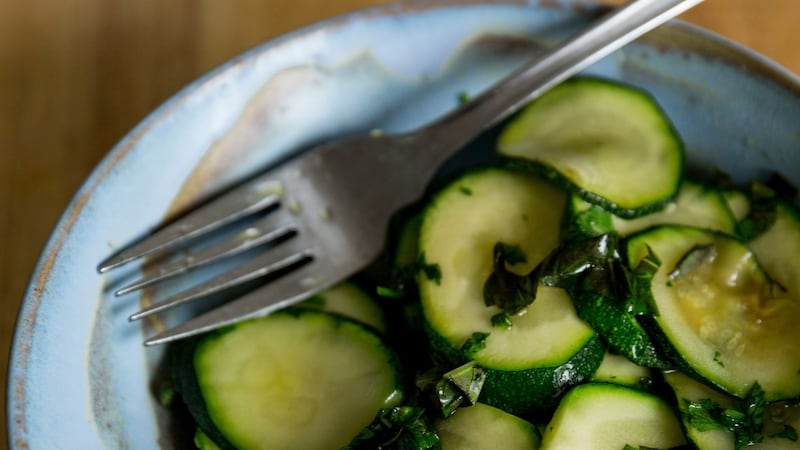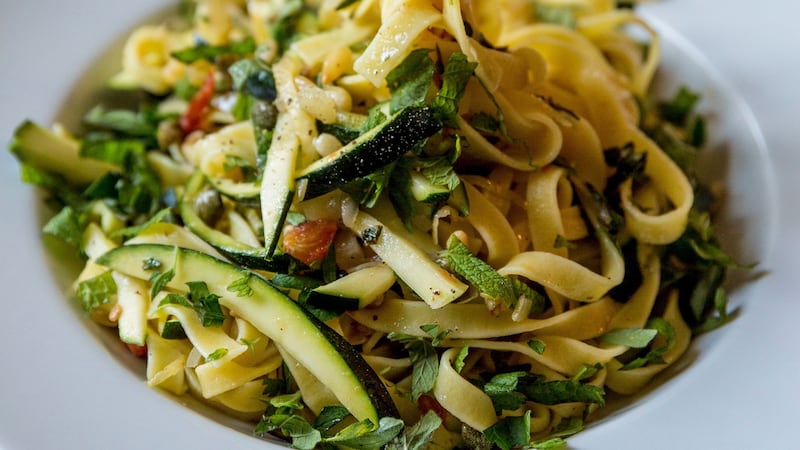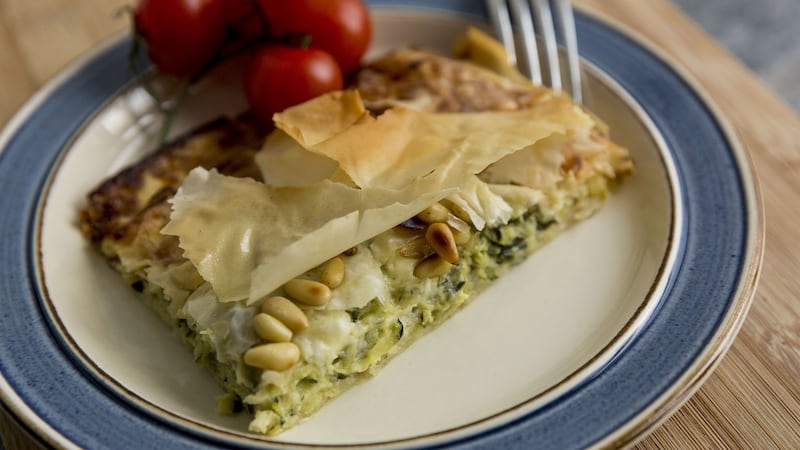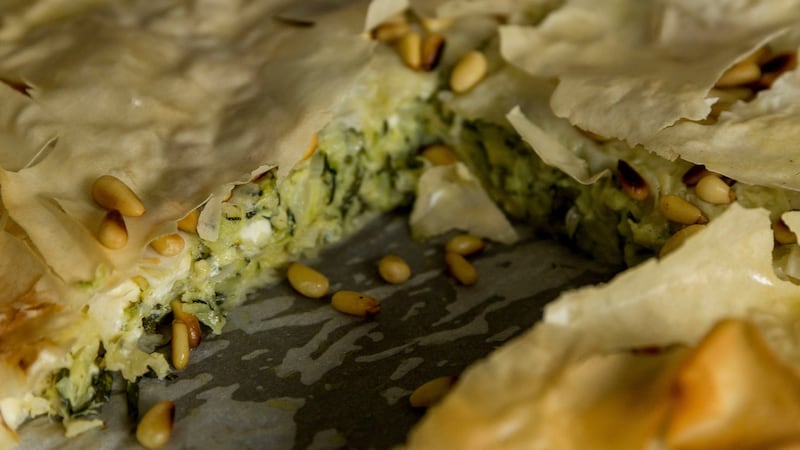Courgettes are the vegetable that keep on giving and inspire the gardener and cook alike. They can be grown in pots, the yield is rewarding without much effort, and then there is always one more hidden behind their impressive leaves.
For the cook, they are versatile, adaptable and look pretty on the plate as well as in the garden. It is when you grow them yourself or manage to buy them while they are small and freshly picked that you will realise how delicious they can be.
They’re always a winner in the kitchen due to their versatility, gladly accompanying meat or fish, while still able to hold there own as a main ingredient. They absorb flavour quickly while still managing to hold their shape. They lend themselves to a wide variety of flavours too, making them suitable for most cuisines, from French, Italian to Asian.
0 of 3
Courgettes are relatively new to us. I can remember cooking them in the early nineties and my dad asking why was I cooking cucumbers. Not even two decades later and they are now as commonplace as their watery cousins and seem to thrive in our climate.
The great English food writer Elizabeth David is credited with introducing them after the second World War with the publication of her first book, A Book Of Mediterranean Food. David, in my mind, is the hero of the courgette (and saved us from the dreaded marrow), having introduced them at a time when rations were still in place and people were craving simple flavours.
Courgettes, along with their southern companion the aubergine, sometimes but not always, need to be salted before cooking. I usually salt when the vegetables are old, or large, but especially when I am cooking them in a lot of oil. The salting process prevents them from soaking up excessive oil, such as when making dishes such as fritters or tempura. I usually aim for a tablespoon of salt to a kilo of courgettes.
Courgettes also produce flowers which are delicate and need to be used the day they are picked as they wilt within hours and can cause great disappointment. They can be dipped in a light batter and fried, or they can be stuffed. If you get to a market early in the day it is worth seeking them out as they are fun to work with and never fail to impress.
The flower as well at the vegetable can be eaten raw, grated large and dressed with a lemon dressing, or sliced thinly to make a carpaccio, topped with basil, chilli, oil and grated aged Coolea cheese.
In the past they have been referred to as the Italians’ answer to cabbage. For me, they are the perfect summer vegetable, especially when our cabbages struggle during these months
Sweet and sour courgettes

This recipe for sweet and sour courgettes comes from Jane Grigson’s vegetable book. We all love sweet and sour and the addition of anchovies gives the dish that extra bite. This dish is great on its own, with some good bread, and great with meat or fish.
Serves 4
1kg courgettes
2 cloves garlic
2 tbsp olive oil
2 tbsp vinegar
2 tbsp water
30g pine nuts
30g sultanas
8 anchovy fillets, chopped
Salt and pepper
1. Using a vegetable peeler, cut strips lengthways along the courgettes, working your way to the core. Chop the core into strips using a knife.
2. Heat the oil in a shallow pan and add the courgettes, season with salt and pepper. Keep them moving until they are coated in oil and just beginning to colour. Crush in the garlic and add the vinegar and water, cover with a lid and simmer for 10 minutes.
3. Remove the lid, add the nuts, sultanas and anchovies and cook on a high heat until the liquid is well reduced. Taste and adjust the seasoning.
Courgettes with garlic and basil

Simple, quick, delicious and dear to my heart. My first introduction to courgettes and basil was while I was living in Paris in the 1980s. A friend invited me to supper and as I arrived at her apartment the air was filled with the smell of garlic and basil. That aroma has stayed with me ever since and I have even been known to buy courgettes and basil out of season to recreate that moment.
Serves 4
750g courgettes, sliced
50ml olive oil
Salt and pepper
2 cloves garlic, crushed
6 large basil leaves
1. Take a shallow pan and heat the olive oil. Add the courgettes and keep them moving around in the oil until they are well coated. Cook on a medium heat until they are just soft in the centre.
2. Add the crushed garlic and mix well, then remove from the heat and place a lid on top and allow to stand for five minutes for the flavours to develop.
3. Roll the basil leaves together and chop into strips. Remove the lid, add the basil and mix well. Allow to sit for another minute before serving.
Pasta with courgettes, lemon, pine nuts and herbs

Usually, when I decide to cook pasta, it is because I’m lazy, don’t want to head to the shops, and do as little work as possible. If you have the ingredients to hand, double the sauce as it will keep, covered, in the fridge for days and will make an ideal dressing for chicken, lamb, fish or drizzled over a tray of roasted vegetables.
Serves 4
400g of your favourite pasta
700g courgettes
For the sauce
30ml olive oil
50g pine nuts
4 large shallots, chopped fine
Salt and pepper
About 25g mixed herbs, such as parsley, mint, basil, chervil or tarragon
2 tbsp capers, rinsed and chopped
4 sun-dried tomatoes, chopped fine
Zest and juice of 1 lemon
50ml olive oil
50g Parmesan cheese, grated
1. Bring a saucepan of water to the boil for the pasta.
2. In the meantime, heat a frying pan and add 30ml of oil followed by the pine nuts and cook on a low heat until they start to colour. Add the shallots, season well with salt and pepper and cook together until the pine nuts are nice and brown and the shallots are soft. Remove from the heat and allow them to cool.
3. Roughly chop the herbs and add to the pan, along with the capers and sun-dried tomatoes.
4. Whisk or whizz the zest, juice of the lemon, the 50ml of olive oil and the cheese together and add to the pine nut and herb mixture.
5. When the water has come to the boil, add salt and the pasta and cook according to the instructions on the packet.
6. Slice the courgettes, line them up and then cut into matchsticks. Or you can use a vegetable peeler and slice them into long strips, which go well if you are using long pasta.
7. When the pasta is just ready to be drained, throw in the courgettes and mix well. Remove from the heat and drain at once. Mix well with the cheese, lemon and pine nut sauce.
Courgette and basil filo with pine nuts

This dish has been on my menu every summer and is always a big hit with vegetarian and non vegetarians alike. The recipe is inspired by Deborah Madison's The Greens Cookbook, which has been one of my vegetable bibles for years.
Working with filo pastry requires a little patience and a bit of patching is nearly always necessary. Children love getting involved in the assembly of this dish, buttering the layers of pastry, sprinkling the pine nuts and, depending on age, grating the courgettes.
This tart only needs a simple tomato salad dressed with sea salt, olive oil and chopped chives
It has been a family favourite for years, appealing to both children and adults alike. The layers of crisp pastry appeal to the child in us all, but the decadence of the dish is perfect for a more sophisticated meal too, with a lovely crisp glass of white wine to complement the buttery nature of courgettes and the hint of cheese.
Serves 4
1 pack frozen filo pastry
5 – 6 medium courgettes (750g)
Salt
125g pine nuts
2 tbsp extra virgin olive oil
2 small red onion, chopped fine
Salt and pepper
2 cloves garlic, finely chopped
12 large basil leaves, chopped
Couple sprigs parsley, chopped
100ml white wine or water
2 eggs
75g Parmesan, grated
100g feta cheese, crumbled
8 tbsp melted butter or a mixture of butter and olive oil
1. Remove the filo pastry from the freezer and let it come to room temperature while you prepare the filling.
2. Unfold the dough, and cut the stack of sheets in two. If you are making just one recipe, refold half the dough, and wrap it in plastic. It can either be refrozen or kept for a few days in the refrigerator. Cover the sheets to be used with a damp kitchen towel, to keep them from becoming dry and brittle.
3. Grate the courgettes on the large holes of a hand grater or food processor. Toss with the salt and set aside for 30 minutes. Rinse and drain and squeeze dry in a clean kitchen towel.
4. Toast the pine nuts in a dry pan until golden brown and then roughly chop them.
5. Heat the olive oil in a frying pan and cook the onion until it begins to soften, about two minutes. Add the courgettes, season with black pepper, and cook for another few minutes, then add the garlic, basil, parsley, and white wine or water. Cook, covered, for 3-4 minutes, and then remove from the heat. Beat the eggs, stir in the cheeses, then the cooked vegetables. Check the seasoning, you might need a little salt depending on the saltiness of the feta.
6. Brush a 9 x 13 x 2 inch pan with the melted butter and lay down a sheet of the filo pastry. Brush the pastry with butter, or a mixture of butter and olive oil, and continue buttering and layering, until you have used half the sheets. Scatter half of the pine nuts between several layers. Brush the top sheet with butter and spread the filling over it. Continue layering the rest of the pastry sheets, buttering each sheet and again distributing pine nuts between several of the sheets. If the butter begins to congeal, reheat it so it will spread easily.
7. Bake in a preheated 180 degree Celsius oven for 40 minutes, or until nicely browned and set.




















